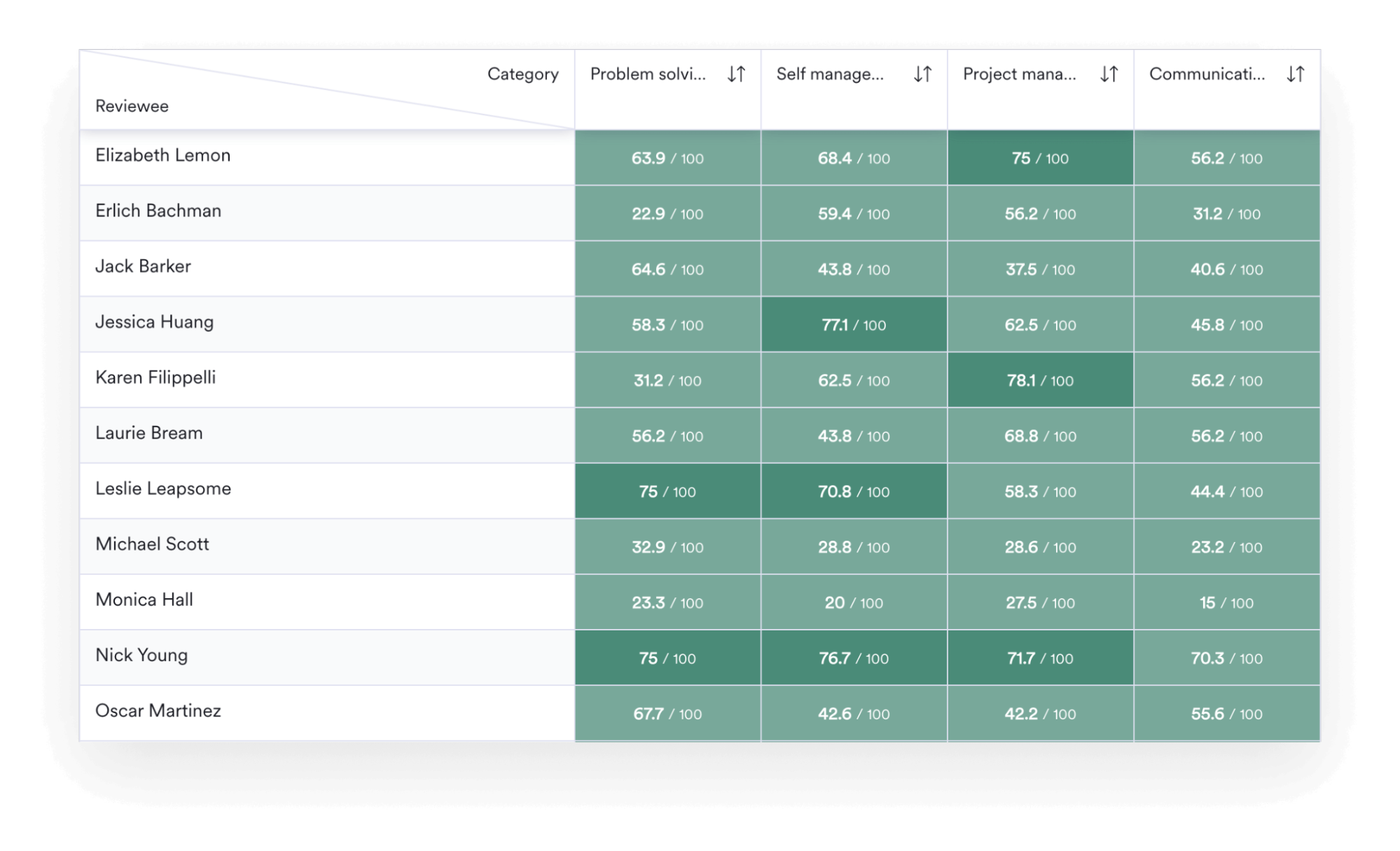Performance tracking: strategies & tools for managers
Top-down, annual performance reviews don’t align with the way many companies operate in the current world of work. Today’s teams are more cross-functional, have flatter hierarchies, pivot between different projects and initiatives more quickly, and often include hybrid and remote team members.
Those are just some of the reasons why many modern organizations are adopting continuous performance tracking rather than periodic, formal performance reviews. Performance tracking provides a more holistic picture of team member performance over time, which is something that people leaders feel is lacking in modern professional environments. Indeed, 77% of HR leaders* agree that traditional evaluations aren’t enough to form an accurate picture of an employee’s day-to-day performance.
If you’re wondering how to track employee performance effectively, we developed this article for you. We’ll discuss why performance tracking is important and provide a step-by-step guide that will teach you how to implement it within your organization.
*Select Software Reviews, 2023
🕵 Curious how Leapsome can help with performance tracking?
Take a gander through Leapsome Reviews and discover how it can streamline your performance management cycle.
👉 Request a product tour
Importance of employee performance tracking
When you take the time to create an employee performance tracking system that's in line with your company goals and culture, it can benefit your organization in many meaningful ways, including:
- Enhancing engagement and satisfaction — Ongoing feedback and continuous performance management conversations foster a healthy rapport between team leads and their reports, allowing employees to feel more valued, supported, and ultimately, bought into your company culture and processes.
- Driving employee development — Performance reviews that focus on professional and personal progress empower team members to take ownership of their careers rather than simply doing what managers and leaders tell them to do. Even better, using a software solution like Leapsome Reviews as an employee performance tracker means leaders can get a more well-rounded, holistic view of people’s progress.
- Allow for more agility and flexibility — Continuous performance tracking enables organizations to quickly identify bottlenecks and shortcomings in their ways of doing things so they can make adjustments as and when issues materialize.
How to track employee performance

Teamwork-oriented performance tracking empowers managers to act as coaches and strategic partners as they guide employees toward achieving their goals. With that in mind, here are a few practical steps that your organization can use as a template to update your approach to employee performance tracking within the performance management cycle.
1. Set realistic goals

Clear goals provide a sense of direction and purpose, and a collaborative goal-setting process helps employees grow in ways that benefit them and their organization. When staff members are involved in setting their own performance objectives, there’s a much higher chance those goals will be met. Plus, enabling your team members to track their progress and impact on the company mission can increase their motivation, productivity, and overall engagement rates.
“Make sure to include and involve the employee in what they want to set out for themselves during a year or a period of three years. You can set those big audacious goals, but you can also set work/life balance goals and think about the person as a whole when thinking about the time period ahead for goal setting.”
— Jennifer Morehead, CEO of Flex HR
If your company utilizes OKR planning, you already have a great framework to support employees with their personal development goals. After aligning on an outcome-focused objective, define three to five measurable key results to guide the employee on the path to reaching their goal. For example, a development OKR for a customer service representative might look something like this:
Objective | Improve written communication skills to the point that I’m the go-to team member for support email assistance and training
- Key result 1: Take a de-escalation training course that results in 20% fewer tickets needing to be escalated to higher tiers of support over the next quarter.
- Key result 2: Practice clearer communication and reduce the number of interactions per ticket by 15% over the next quarter.
- Key result 3: Receive an average customer feedback score of 4.5/5 over the next six months.
- Key result 4: Start a monthly team development workshop where we share our trickiest customer interactions and brainstorm how we could have dealt with them better.
If you’re not using OKRs, or you’d like to keep your individual employee goals a bit simpler, the SMART goals framework is a great approach. SMART means your aims should be specific, measurable, achievable, relevant, and timely. A SMART goal might look like this for the same customer service employee:
- “My goal is to improve my written communication skills throughout the next quarter by investing in professional development opportunities like team workshops and a training course. To track my progress, I’m aiming to reduce ticket escalations and interactions per ticket, as well as increase my customer feedback score.”
⚡ Empower team members to laser-focus on their performance
Leapsome can centralize your performance review and OKR data to create more alignment and transparency.
👉 Discover Leapsome Goals for performance tracking
2. Review progress regularly
It’s important to note that organizations should not use routine progress monitoring to surveil productivity, as this diminishes trust between employers and employees. Instead, team members should think of performance tracking as a way to stay ahead of bottlenecks, and managers should approach it as a way to facilitate learning and development.
Outside of performance evaluations and informal 1:1s, leverage feedback tools and asynchronous communication channels to discuss which goals are moving forward and which are gridlocked. Managers can ask team members questions like:
- Are there any adjustments or changes you need to make to your approach to stay on track?
- Do you need any additional support or resources to achieve your goals?
- Have you met any milestones or achieved any subgoals?
❤️🩹 Does your review process need some attention?
Leapsome is highly customizable, so you can design the performance tracking system that works best for you.
👉 Discover Leapsome Reviews
3. Encourage self-monitoring with tracking tools
One advantage of people enablement software is that it makes tracking employee performance more efficient. In fact, 97% of HR leaders and 89% of employees agree that their organizations benefit from using it.
Still, not all platforms have a straightforward design, so it’s important to invest in an employee performance tracker that’s intuitive to use. The best tools for keeping track of employee performance — like Leapsome Goals and Reviews — allow you to monitor progress with statuses like on track, delayed, and off track, show completion percentage, and detail improvement over time. Moreover, our Goal Tree feature enables you to view how progress is impacting your wider organizational objectives.

4. Assess development in 1:1s

Some companies have chosen to stop doing semi-annual formal performance reviews in favor of weekly or bi-weekly 1:1 check-ins. Others have kept their traditional assessments in place and supplement them with more frequent, informal meetings.
Whatever your approach to reviews and development, regular virtual or in-person meetings are crucial for managers and their direct reports to assess whether team members are on track to reach their goals. If that’s not the case, they’re an opportunity to leverage your performance management system and work together on strategies and solutions.
Keep these best practices in mind ahead of your meetings:
- Review progress at the start of each meeting to identify milestones and barriers to progress.
- Make the meetings collaborative and empower your reports to come up with ideas.
- Set action items for employees to take charge of before the next meeting so it’s clear what they need to work on.
- Don’t ask for 100% success with goals. In most frameworks, a success rate of 70% or 80% is already a good indicator of progress. As Donald and Charles Sull wrote for the MIT Sloan Management Review: “The widespread practice of requiring employees to achieve 100% of their goals to earn a bonus or a positive performance review reinforces the tendency to set conservative goals they’re sure to achieve.”
“My number one tip is to never expect your employees to achieve 100% of their goals. The pressure it creates isn’t worth the potential benefits. The stress of knowing that there’s no margin for error not only doesn’t enhance performance, it also paralyzes the employees, effectively blocking them from undertaking any risks and being inventive, which is never good news. So let humans be humans and know that there’s no growth without some errors to learn from.”
— Piotr Sosnowski, Head of People at Life and My Finances
🕶️ Action items shouldn’t be “out of sight, out of mind”
Leapsome’s platform carries action points over to the next meeting until you’ve tackled them, so nothing falls through the cracks.
👉 Get Leapsome’s meetings tool for free
Optimize your performance management system with Leapsome

How to keep track of employee performance is a living, cyclical process that never stops evolving. That’s why leveraging the right performance management software solution is crucial.
Not only do platforms like Leapsome allow you to create easy-to-use workflows, but they also incorporate powerful analytics that enable you to digest data, identify trends, and make evidence-based decisions to improve employee performance.
However, while other solutions might offer multiple disconnected tools and call themselves “all-in-one,” Leapsome is a truly interconnected platform that intuitively syncs goals, performance reviews, and 1:1 meeting agendas to help you design a performance management system that motivates employees and drives ideal business outcomes.
⚡ Powerful performance tracking to energize your organization
Make Leapsome your solution for collaborative, goal-oriented performance reviews, and watch your engagement rates increase.
👉 Book a demo
Performance tracking FAQs
1. What is the purpose of tracking employee performance?
The primary purpose of performance tracking is to develop employees professionally in line with strategic business goals and, in turn, help organizations grow.
More specifically, when companies track employee performance, it empowers them to:
- Set objectives for individual employees that feed into wider organizational goals
- Monitor progress toward these goals
- Assess employees’ contributions to an organization's overall success
- Identify team members who may need additional training or support
- Recognize and reward high-performing employees
- Foster engagement and satisfaction with regular coaching and feedback
2. How often should employee performance be tracked?
How often you should track employee performance depends on your organization’s culture, needs, goals, and resources. In general, the best way to track employee performance and discuss individual progress is:
- Weekly or biweekly with informal check-ins or 1:1 meetings
- Quarterly or semi-annually with formal evaluations or 360-degree assessments
- Annually in a meeting to set objectives for the year ahead and assess past progress
3. How can employee performance tracking improve employee engagement?
Employee performance tracking can improve employee engagement by:
- Setting and clarifying expectations — When team members understand what’s being asked of them, they’re more likely to be engaged and motivated to meet those expectations.
- Exchanging feedback — By providing constructive input regularly, managers can help employees feel valued and supported, which can increase their sense of satisfaction.
- Identifying development opportunities — Highlighting future opportunities can prompt team members to develop new skills and improve their job performance, allowing them to feel a greater sense of buy-in.
- Creating a culture of accountability — When performance tracking is done consistently and effectively, it encourages employees to take more ownership of their work.
4. What are the legal implications of employee performance tracking?
Employee performance tracking has several legal implications that organizations should be aware of in order to stay compliant with relevant regulations. They must keep the following in mind when deciding how to track the performance of employees:
- Complying with privacy laws when collecting and storing employee performance data.
- Ensuring their performance tracking practices don’t discriminate against people based on protected characteristics such as race, gender, age, disability, religion, or national origin.
- Not retaliating against employees for raising concerns about performance tracking practices or for participating in investigations or complaints related to performance tracking.
- Keeping accurate records of employee performance evaluations and related data in compliance with record-keeping laws.
- Following applicable labor laws related to performance evaluations, including those related to compensation, promotions, and terminations.
Sind Sie bereit, Ihre Strategie zur Mitarbeiterförderung zu verbessern?
your People operations?
Informieren Sie sich über unsere Leistungsbeurteilungen, Ziele und OKRs, Engagement-Umfragen, Onboarding und mehr.
.webp)
.webp)
 Fordern Sie noch heute eine Demo an
Fordern Sie noch heute eine Demo an






























